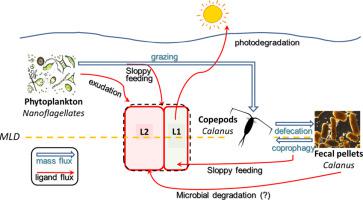当前位置:
X-MOL 学术
›
J. Mar. Syst.
›
论文详情
Our official English website, www.x-mol.net, welcomes your
feedback! (Note: you will need to create a separate account there.)
Iron organic speciation during the LOHAFEX experiment: Iron ligands release under biomass control by copepod grazing
Journal of Marine Systems ( IF 2.7 ) Pub Date : 2020-07-01 , DOI: 10.1016/j.jmarsys.2019.02.002 Luis M. Laglera , A. Tovar-Sanchez , C.F. Sukekava , H. Naik , S.W.A. Naqvi , D.A. Wolf-Gladrow
Journal of Marine Systems ( IF 2.7 ) Pub Date : 2020-07-01 , DOI: 10.1016/j.jmarsys.2019.02.002 Luis M. Laglera , A. Tovar-Sanchez , C.F. Sukekava , H. Naik , S.W.A. Naqvi , D.A. Wolf-Gladrow

|
Abstract The LOHAFEX iron fertilization experiment consisted in the fertilization of the closed core of a cyclonic eddy located south of the Antarctic Polar Front in the Atlantic sector of the Southern Ocean. This eddy was characterized by high nitrate and low silicate concentrations. Despite a 2.5 fold increase of the chlorophyll-a (Chl-a) concentrations, the composition of the biological community did not change. Phytoplankton biomass was mostly formed by small autotrophic flagellates whereas zooplankton biomass was mostly comprised by the large copepod Calanus simillimus. Efficient recycling of copepod fecal pellets (the main component of the downward flux of organic matter) in the upper 100–150 m of the water column prevented any significant deep export of particulate organic carbon (POC). Before fertilization, dissolved iron (DFe) concentrations in the upper 200 m were low, but not depleted, at ~0.2 nM. High DFe concentrations appeared scattered from day 14 onwards as a result of the grazing activity. A second fertilization on day 21 had no significant effect on the DFe and Chl-a standing stocks. Work with unfiltered samples using different acidification protocols revealed that, by midway of LOHAFEX, rapid recycling of iron-replenished copepod fecal pellets explained the source of bioavailable iron that prolonged the duration of the bloom for many weeks. Here we present the evolution of the organic speciation of iron in the upper 200 m of the water column during LOHAFEX by a Competing Ligand Equilibrium method using voltammetry. During the first 12 days of the experiment, ligands of an affinity for iron similar to the ligands found before fertilization (logK′Fe′L~11.9) accumulated in fertilized waters mostly in the upper 80 m (from ~1 nM to ~2.5 nM). The restriction of ligand accumulation to the depth of Chl-a penetration points to exudation by the growing autotrophic population as the initial source of ligands. From day 5 onwards, we found in many samples a new class of ligands (L1) characterized by a significant higher conditional stability constant than the background complexation (logK′Fe′L1~12.9). During the middle section of the experiment (days 12 to 25) the accumulation of overall ligands and specifically L1, reached an upper limit in surface waters (at ~3 nM). Overall ligands and L1 accumulation was also observed below the mixed layer depth indicating that grazing was the process behind ligand release. During the last 10 days of the experiment ligands kept accumulating in deep waters but suffered a small decrease in the upper 50 m of the water column caused by the vanishing of L1. Ligand removal restricted to the euphotic layer was probably caused by photodegradation. A high correlation between [DFe] and [L1] suggested that recycled iron (released during grazing and copepod fecal pellet cycling) was in the form of FeL1 complexes. We hypothesize that the iron binding ligands released to the dissolved phase during LOHAFEX were mostly photosensitive intracellular ligands rapidly degraded in extracellular conditions (e.g.: pigments). Sloppy feeding by copepods and recycling of cells and cellular material in copepod fecal pellets caused the transfer of particulate ligands to the dissolved phase as zooplankton built up as a response to the blooming community.
中文翻译:

LOHAFEX 实验中的铁有机形态:在生物量控制下桡足类放牧释放铁配体
摘要 LOHAFEX 铁施肥实验包括对位于南大洋大西洋部分南极极地锋以南的气旋涡旋的封闭核心施肥。这种涡流的特点是高硝酸盐和低硅酸盐浓度。尽管叶绿素-a (Chl-a) 浓度增加了 2.5 倍,但生物群落的组成并没有改变。浮游植物生物量主要由小型自养鞭毛虫形成,而浮游动物生物量主要由大型桡足类 Calanus simillimus 组成。桡足类粪便颗粒(有机物质向下通量的主要成分)在水体上部 100-150 m 中的有效循环防止了颗粒有机碳 (POC) 的任何显着的深层输出。受精前,上层 200 m 中的溶解铁 (DFe) 浓度较低,但未耗尽,约为 0.2 nM。由于放牧活动,从第 14 天开始,高 DFe 浓度出现分散。第 21 天的第二次施肥对 DFe 和 Chl-a 常备库存没有显着影响。使用不同酸化方案处理未经过滤的样品表明,在 LOHAFEX 中途,补充铁的桡足类粪便颗粒的快速回收解释了生物可利用铁的来源,延长了水华的持续时间数周。在这里,我们通过使用伏安法的竞争配体平衡方法展示了 LOHAFEX 期间水柱上部 200 米中铁的有机形态的演变。在实验的前 12 天,对铁具有亲和力的配体与受精前发现的配体 (logK'Fe'L~11.9) 相似,主要在受精水中积累,主要在上层 80 m(从~1 nM 到~2.5 nM)。配体积累对 Chl-a 渗透深度的限制指向作为配体初始来源的自养种群的渗出。从第 5 天开始,我们在许多样品中发现了一类新的配体 (L1),其特征是条件稳定性常数明显高于背景络合 (logK'Fe'L1~12.9)。在实验的中间部分(第 12 天到第 25 天),整个配体的积累,特别是 L1,在地表水中达到了上限(约 3 nM)。在混合层深度以下还观察到总体配体和 L1 积累,表明放牧是配体释放背后的过程。在实验的最后 10 天里,配体在深水中不断积累,但由于 L1 的消失而导致水柱上部 50 m 略有减少。仅限于透光层的配体去除可能是由光降解引起的。[DFe] 和 [L1] 之间的高度相关性表明回收的铁(在放牧和桡足类粪便颗粒循环过程中释放)以 FeL1 复合物的形式存在。我们假设在 LOHAFEX 期间释放到溶解相的铁结合配体主要是在细胞外条件下迅速降解的光敏细胞内配体(例如:色素)。
更新日期:2020-07-01
中文翻译:

LOHAFEX 实验中的铁有机形态:在生物量控制下桡足类放牧释放铁配体
摘要 LOHAFEX 铁施肥实验包括对位于南大洋大西洋部分南极极地锋以南的气旋涡旋的封闭核心施肥。这种涡流的特点是高硝酸盐和低硅酸盐浓度。尽管叶绿素-a (Chl-a) 浓度增加了 2.5 倍,但生物群落的组成并没有改变。浮游植物生物量主要由小型自养鞭毛虫形成,而浮游动物生物量主要由大型桡足类 Calanus simillimus 组成。桡足类粪便颗粒(有机物质向下通量的主要成分)在水体上部 100-150 m 中的有效循环防止了颗粒有机碳 (POC) 的任何显着的深层输出。受精前,上层 200 m 中的溶解铁 (DFe) 浓度较低,但未耗尽,约为 0.2 nM。由于放牧活动,从第 14 天开始,高 DFe 浓度出现分散。第 21 天的第二次施肥对 DFe 和 Chl-a 常备库存没有显着影响。使用不同酸化方案处理未经过滤的样品表明,在 LOHAFEX 中途,补充铁的桡足类粪便颗粒的快速回收解释了生物可利用铁的来源,延长了水华的持续时间数周。在这里,我们通过使用伏安法的竞争配体平衡方法展示了 LOHAFEX 期间水柱上部 200 米中铁的有机形态的演变。在实验的前 12 天,对铁具有亲和力的配体与受精前发现的配体 (logK'Fe'L~11.9) 相似,主要在受精水中积累,主要在上层 80 m(从~1 nM 到~2.5 nM)。配体积累对 Chl-a 渗透深度的限制指向作为配体初始来源的自养种群的渗出。从第 5 天开始,我们在许多样品中发现了一类新的配体 (L1),其特征是条件稳定性常数明显高于背景络合 (logK'Fe'L1~12.9)。在实验的中间部分(第 12 天到第 25 天),整个配体的积累,特别是 L1,在地表水中达到了上限(约 3 nM)。在混合层深度以下还观察到总体配体和 L1 积累,表明放牧是配体释放背后的过程。在实验的最后 10 天里,配体在深水中不断积累,但由于 L1 的消失而导致水柱上部 50 m 略有减少。仅限于透光层的配体去除可能是由光降解引起的。[DFe] 和 [L1] 之间的高度相关性表明回收的铁(在放牧和桡足类粪便颗粒循环过程中释放)以 FeL1 复合物的形式存在。我们假设在 LOHAFEX 期间释放到溶解相的铁结合配体主要是在细胞外条件下迅速降解的光敏细胞内配体(例如:色素)。











































 京公网安备 11010802027423号
京公网安备 11010802027423号